
|   |

|   |
A treat for dance connoisseurs in the City of Joy - Shyamhari Chakra e-mail: shyamharichakra@gmail.com Photos courtesy: Lubdhak Chatterjee October 8, 2024 Both of them belonged to two different professions and cities. One is a Delhi based filmmaker and the other is an Odissi dancer who is now back in her Himalayan hometown of Jalpaiguri after a stint in Indonesia. However, it was a common bond between them - both are Bengalis by birth having a strong weakness for dance and Kolkata, the city that had triggered in them sparks of creativity - that they decided to host a unique dance event in the "City of Joy". They were filmmaker Lubdhak Chatterjee and dancer Pompi Paul who came together to host the two-day Kalpodip Utsav in Kolkata on September 7-8. The festival featured two internationally acclaimed star soloists of Indian classical dances - Rama Vaidyanathan (Bharatanatyam) and Bijayini Satpathy (Odissi) apart from Odissi by host Pompi Paul's Kalpodip Ensemble. The festival further showcased a conference on Indian dance scene that was aptly titled Kala Manthan. The tastefully and carefully curated events were mounted at two historic venues which are, literally, revered as temples of culture in Kolkata. The Uday Shankar Hall of Jorasanko Thakur Bari - the iconic ancestral home of Rabindranath Tagore where the Nobel laureate was born and had breathed his last - was chosen as the venue for the conference while G D Birla Sabhagar, the attractive auditorium located under the majestic Radha Krishna temple in the heart of the city as a cultural complex, was the venue for the performances. If Rama Vaidyanathan and Bijayini Satpathy perform, can the crowd of connoisseurs stay far behind! The long queue at the entrance of the auditorium - it was a ticketed show - spoke volumes of the high degree of excitement that the two celebrity dancers had generated. 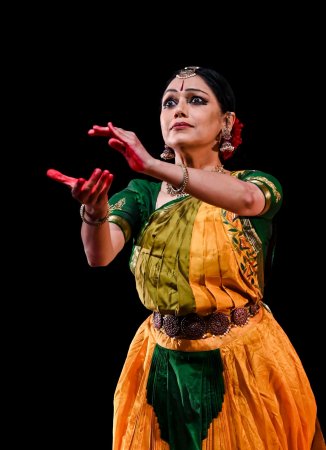 Rama Vaidyanathan If you ever felt that Bharatanatyam is all about geometry and symmetry, you should have watched Rama Vaidyanathan's Saamya (equilibrium) that was poetry in motion in her intensely lyrical limb-language. The peerless production - choreographed and presented in solo format - was premiered in Chennai during August for the Natyarangam festival at Narada Gana Sabha and Kolkata was the next city to experience it. Weaving excerpts from the Rig Veda, Yajur Veda, Kausitaki Brahmana, Sangam, Kalidas, Soordas, Amir Khusrau and a composition of Vidwan GN Balasubramaniam into a convincing narrative, Rama's Saamya revolved round spring - the season of equanimity. Spread over four segments - Saamya, Punaraavartana, Kaamarogini and Bahuvarnani, the choreography eulogized the salient features of the king of the seasons. Prior to portrayal of each segment on stage, the dancer made a backstage lucid narration of the attributes as the protagonist in first person that added to the appeal of the production. Sample this: "People call me Vasantha, and just the mention of my name, signifies pleasure and equanimity. I am SAAMYA. I appear during a cosmic phenomenon called the vernal equinox when the position of the earth in front of the sun is such, that the nights are equal to the days. The long nights and short days of the winter gradually balance out and nature enters into a period of tranquillity. Even Lord Krishna in the Bhagwad Gita called himself the spring of all seasons stating that I represented God's opulence the most. I am the ultimate equilibrium. I am SAAMYA." 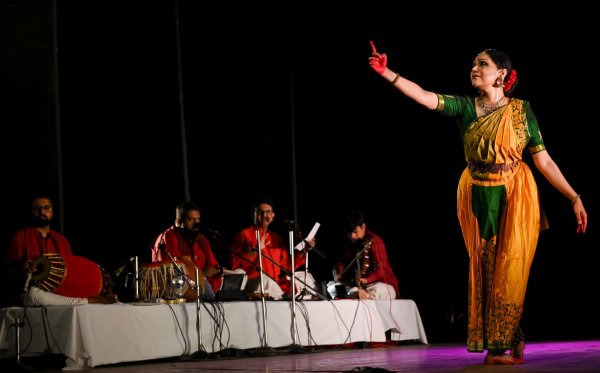 Rama Vaidyanathan The next segment - Punaraavartana - narrated how the return of spring triggers total transformation of the earth with rejuvenation. One gets amazed at the sight of sprouting of new plant life and the flowers that fill the world with colour. It's the time for fresh beginnings - whether sowing of seeds or harvesting the full-grown crop. And it's also the time to worship Saraswati, the deity of arts and education. The dancer's fingers created an apt illusion of all these acts - be it the sprouting of the seeds, plucking of flowers, of the flying of the kites. Moving on, the third episode - Kaamarogini - explored the intensity of love, longing and passion that the season of spring is known for. The nature is decked up as a beautiful bride and in the raging hue of red symbolising passion. A handsome one flying on the parrot, with a bow of sugarcane, and a bow string of buzzing bees, striking arrows of newly sprouted leaves from the mango tree. He goes around like an assailant, inflicting his arrows to invoke unabashed and uncontrolled desire. And the presence of spring as the Kaamarogini is inspiring for hearts and bodies to unite. The fourth and finale episode, aptly titled Bahuvarnani, was a unique synthesis of performing and visual mediums of art. Here, Kolkata's well-known light designer Dinesh Poddar assisted by Nilava Sen created magic on the stage in tune with the choreographer's creative vision. A door-like frame within the frame of the stage space was created by manipulating the light designs. And the dancer performed four different sequences of Bahuvarnani from within the frame creating surreal scenes. "Look around me. Every frame is like a painting, and I am within those spectacular images captured within the numerous frames. Enter into them to marvel at the splash of vibrancy". As the protagonist enacted these words and came out of the framed door, finally, on to the stage, the dancer became the dance in her dance of ecstasy. Rama Vaidyanathan's live orchestra magnified the impact of her presentation with music composition and vocal rendition by Dr S Vasudevan, rhythmic compositions, mridangam and tabla by Manohar Balatchandirane; Ghatam, kanjira and nattuvangam by Varun Rajashekar and violin by Vishwesh Swaminadhan. 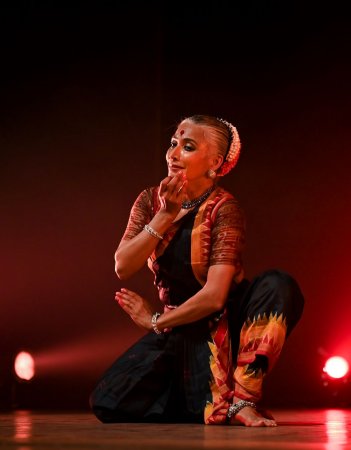 Bijayini Satpathy Celebrated Odissi soloist Bijayini Satpathy - who hardly needs an introduction - was wisely scheduled for the finale of the festival by the curators who were aware that there was a huge craze among the connoisseurs to watch the dancer who performed for the first time on a proscenium stage in Kolkata. Recurring rounds of loud applause for her - even before she descended on the stage - spoke volumes of the audience excitement. Bijayini commenced her concert with Call of Dawn set to Raga Chakravāka, the melody of dawn, when Chakora birds call out for their mates in eager anticipation of union after a night of separation. Choreographed by her with music composition and vocal rendition by Bindhumalini Narayanswamy, National Film Award winner as best playback singer apart from a famed composer and graphic designer, and music arrangement by Bijayini's Ustad Bismillah Khan Award winner flutist brother Srinibas Satapathy, Call of Dawn was a two-part performance. Vigraha, the first part, delineated a young maiden's encounter of the iconic image of Ardhanariswara. An Adi Shankaracharya stotra, it has been set as a preface, in which a young woman, poised to be married, imagines her approaching union and revels in the seamless, harmonious one-ness of the masculine and the feminine. As the dancer emerged from a smoke and fog filled background on stage under subdued light, the audience encountered an awe-struck mystical image of the half male and half female body. As the recital progressed, we witnessed a dancer with incredible command over her body that spoke a distinctly different and eloquent body-language. 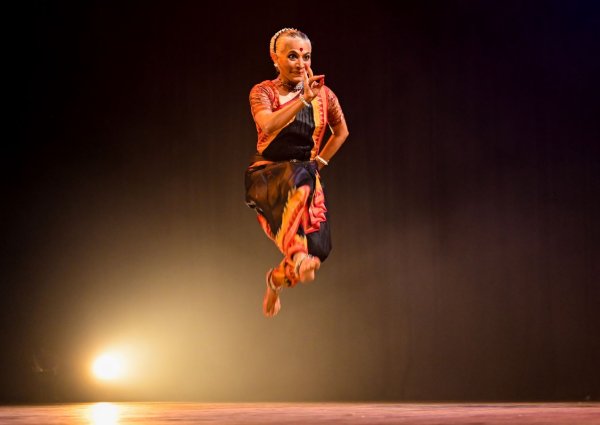 Bijayini Satpathy Vigraha was followed by an immensely popular Kazi Nazrul Islam song - Aruno kanti ke go jogi bhikhari. The protagonist here - again a young woman like in the previous presentation - expresses her choice for a companion as Krishna and unlike Shiva. Krishna, for her, is accessible and not intimidating, passionate and not fierce, approachable and not forbidding like Shiva. Retaining the original composition, the song has been sung by Bindhumalini Narayanswamy set to music arrangement by Srinibas Satapathy. A song by Nazrul - who is not just the national poet of Bangladesh but the heartthrob of all the Bengalis on both sides of the border - was a wise choice by Bijayini Satpathy that stirred hearts of the audience in Bengal's capital city many of whom were seen singing along the music track. Bijayini concluded her recital with Sitaharan, the story of abduction of Sita from Ram Charit Manas of Tulsidas, the celebrated soloist's magnum opus performance that has been in great demand over the decades. Her quick and clear transition and transformation to several characters - Rama, Ravana, Jatayu, Sita, the golden deer et al - are to be seen to be believed. A choreography by Guru Kelucharan Mohapatra, it has been heavily edited by late Protima Gauri Bedi - Bijayini's guru and mentor - and later by the dancer herself. As a result, the production has been an abridged version of the Kelucharan choreography that has assumed a new look with more suggestive and less elaborative acts. Even the music - originally composed by Pandit Raghunath Panigrahi - has been scored by Asit Desai under guidance of Pandit Jasraj.  Pompi Paul The festival also featured a solo and two group Odissi recitals by Kalpodip, the Odissi dance institute that hosted the event. While Pompi Paul, Kalpodip founder, performed the complex Mia Malhar Pallavi choreographed by her Guru Poushali Mukherjee with elan, her male disciples staged an impressive presentation of her choreography Shiv Tandav Stotram while her female disciples presented Durga Dhyan, a Guru Kelucharan Mohapatra choreography. KALA MANTHAN CONFERENCE Aptly titled Kala Manthan, the conference on Indian dance, was also an apt choice to go as the curtain-raiser of the festival. It commenced with a lecture-demonstration on Odissi Mardal (percussion instrument) by Guru Poushali Mukherjee, distinguished disciple of Guru Kelucharan Mohapatra who was the lone female mardal exponent of the world so far. It was followed by Bijayini Satpathy in conversation with Shyamhari Chakra; Idiosyncrasies in compositions of Pt Jailal Misra and Pt Ramgopal Misra - a talk by Kajal Misra Roy; Embodiment through psycho physicality - the three pramanas and sensorimotor experiences in acting and actor's practices by eminent scholar Piyal Bhattacharya; a panel discussion on the South Indian classical dance scene in West Bengal featuring Shankar Narayanswamy, Madhuri Majumder, Vandana and Jalsa Chandra; another panel discussion on dance criticism by Kathakali Jana and Shyamhari Chakra and finally a talk on "Mentoring students in present times" by Rama Vaidyanathan. 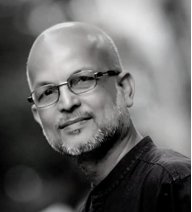 A former journalist and arts critic with The Indian Express and The Hindu newspapers for over two decades, Shyamhari Chakra is a New Delhi based independent journalist writing on cultural affairs. |